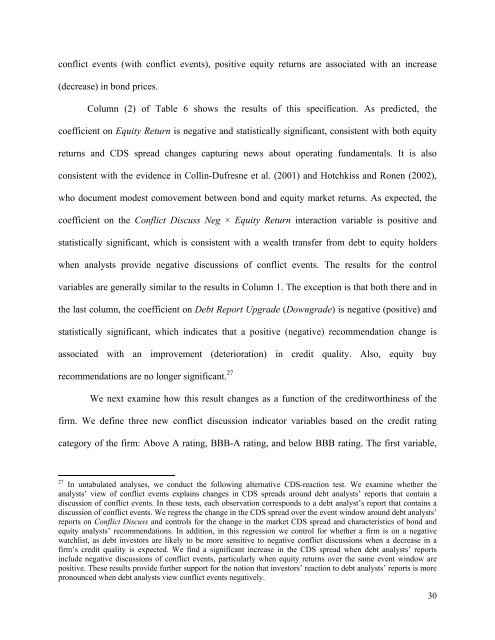Debt Analysts' Views of Debt-Equity Conflicts of Interest
Debt Analysts' Views of Debt-Equity Conflicts of Interest
Debt Analysts' Views of Debt-Equity Conflicts of Interest
You also want an ePaper? Increase the reach of your titles
YUMPU automatically turns print PDFs into web optimized ePapers that Google loves.
conflict events (with conflict events), positive equity returns are associated with an increase<br />
(decrease) in bond prices.<br />
Column (2) <strong>of</strong> Table 6 shows the results <strong>of</strong> this specification. As predicted, the<br />
coefficient on <strong>Equity</strong> Return is negative and statistically significant, consistent with both equity<br />
returns and CDS spread changes capturing news about operating fundamentals. It is also<br />
consistent with the evidence in Collin-Dufresne et al. (2001) and Hotchkiss and Ronen (2002),<br />
who document modest comovement between bond and equity market returns. As expected, the<br />
coefficient on the Conflict Discuss Neg × <strong>Equity</strong> Return interaction variable is positive and<br />
statistically significant, which is consistent with a wealth transfer from debt to equity holders<br />
when analysts provide negative discussions <strong>of</strong> conflict events. The results for the control<br />
variables are generally similar to the results in Column 1. The exception is that both there and in<br />
the last column, the coefficient on <strong>Debt</strong> Report Upgrade (Downgrade) is negative (positive) and<br />
statistically significant, which indicates that a positive (negative) recommendation change is<br />
associated with an improvement (deterioration) in credit quality. Also, equity buy<br />
recommendations are no longer significant. 27<br />
We next examine how this result changes as a function <strong>of</strong> the creditworthiness <strong>of</strong> the<br />
firm. We define three new conflict discussion indicator variables based on the credit rating<br />
category <strong>of</strong> the firm: Above A rating, BBB-A rating, and below BBB rating. The first variable,<br />
27 In untabulated analyses, we conduct the following alternative CDS-reaction test. We examine whether the<br />
analysts’ view <strong>of</strong> conflict events explains changes in CDS spreads around debt analysts’ reports that contain a<br />
discussion <strong>of</strong> conflict events. In these tests, each observation corresponds to a debt analyst’s report that contains a<br />
discussion <strong>of</strong> conflict events. We regress the change in the CDS spread over the event window around debt analysts’<br />
reports on Conflict Discuss and controls for the change in the market CDS spread and characteristics <strong>of</strong> bond and<br />
equity analysts’ recommendations. In addition, in this regression we control for whether a firm is on a negative<br />
watchlist, as debt investors are likely to be more sensitive to negative conflict discussions when a decrease in a<br />
firm’s credit quality is expected. We find a significant increase in the CDS spread when debt analysts’ reports<br />
include negative discussions <strong>of</strong> conflict events, particularly when equity returns over the same event window are<br />
positive. These results provide further support for the notion that investors’ reaction to debt analysts’ reports is more<br />
pronounced when debt analysts view conflict events negatively.<br />
30
















